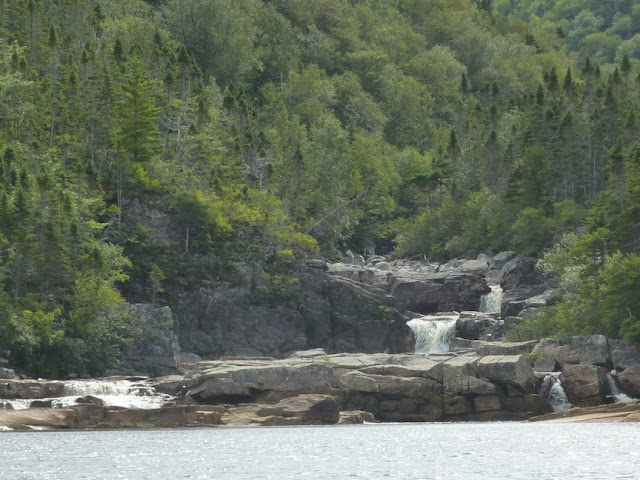Saturday- Clear and sunny, smooth then a bit breezy
Ann writes:
A great day for birdwatchng. The Bald Eagles were catching thermals until they were almost out of sight and then taking off for other destinations, just like Jon when he flies his glider cross-country. I saw 5 Great Blue Herons by the Smokehouse, 4 Cormorants, 3 Bald Eagles, 2 jelleyfish and an eastern Blue Jay, all before lunch.
We had our best lunch in Canada at the Cape Breton Smokehouse- this time we both went for the smoked salmon plate which included the dense, nutty german bread, hardboiled egg, red onions, creamy horseradish and classical music in the huge log dining room overlooking the sparkly bay. We were the only ones in the room for most of the meal. The captain/cook came out and helped Jon get the internet weather forecast on his laptop, and they showed us their Nova Scotia cruising guides that seem to be out of print now. They had several that Jon was unable to find.
The anchor was slow in coming up, absolutely caked with mud, but I enjoyed the Bald Eagle circling overhead. Our first stop was Clarks Cove and Marble Mountain. The "white chip marble beach" wasn't quite as white as we imagined, nor the water a blue as described, and it was filled with thousands of nasty looking little orange jelley fish that the locals assured us were harmless. We anchored long enough to explore the beach and inspect the work being done on the public wharf.
Our anchorage for the night was difficult in the Crammond Islands due to great depth near shore and mosquitoes; 3 more bites on my hand. I had to slather DEET all over me, but it was all made up for by the bald eagle perched on a nearby tree. He was really comical. The eagle was so big he bent the tip of the evergreen over and was awkwardly holding on with his golden talons. You could clearly see his golden beak on his magnificent white head, although in flight I've noticed that you see the white tail first.
Jon writes:
The day started calm and clear. Having no particular reason to leave early, we waited until noon and went ashore to the Smoke House again, this time both ordering the smoked salmon platter. Again very simply and perfectly prepared, beautifully arranged and presented on the plate. After lunch the proprietor came by with his laptop to show us the weather report: fortunately it looked as though Hurricane Igor would be passing well to the east. Good for us, not so good for Bermuda. I was also happy not to be in eastern Newfoundland still.
In calm conditions we motored to the white marble beach at Clarke Cove and anchored a few feet off the wharf for lunch. We weighed anchor and proceeded to the Crammond islands further down the West Bay of the Bras d'Or. The channel between the two islands creates a sheltered cove and though we found the water to be fairly deep throughout, we managed to anchor in 25 feet for the night. A bald eagle greeted us on the way in, perched in the tip of a fir rather unsuited for his weight.
 |
| Too big for his perch |
 |
| The bald eagle contemplates 'Anomaly' |
 |
| Ann contemplates the bald eagle, now a few trees further off |
'Anomaly' is currently lying Pilotage Wharf, Halifax, Nova Scotia









































